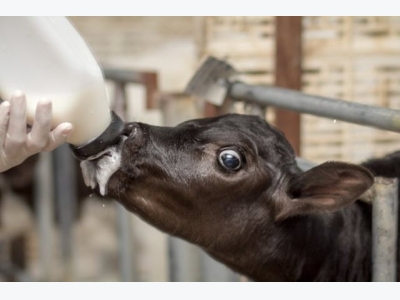Volatile fatty acids boosts calf growth, rumen development

Calves getting 2-methylbutyrate see improved rumen development and boosted growth, say researchers.
An international team of researchers from China and the Agriculture and Agri-Food Research Center in Canada examined the use of supplemental 2-methylbutyrate in dairy calves.
The group published their results in the journal of Animal Feed Science and Technology.
“The aim of this work was to evaluate the effects of 2-methylbutyrate on growth performance and ruminal development in pre- and post-weaned dairy calves,” said the researchers.
They found the feed additive boosted calf growth and development, both for pre-weaned and post-weaned calves, said the researchers.
“Results indicated that 2-methylbutyrate accelerated growth of calves by improving rumen development and its ketogenesis,” they said in the study. “The 2-methylbutyrate stimulates the growth performance and rumen development of dairy calves in a dose-dependent manner.”
Why 2-methylbutyrate?
Rumen development and function influence nutrient deliver, absorption, the metabolism and can support calf health and potential future performance, said the researchers. Changes to the morphology of the rumen influences metabolic function, slow the oxidation of glucose and boost oxidation of volatile fatty acids (VFD) and ketogenesis of rumen epithelium.
“Ruminal fermentation products, one of the important factors affecting the development of rumen, not only provide energy for the growth of epithelial tissue and muscle contraction, but also directly affect the proliferation and differentiation of epithelial cells,” they said.
Rumen development work has been done with butyrate, acetate and propionate, they said. And all are known to be chemical stimulators of the rumen.
It has been posited that feed additives that generate more VFA, especially butyrate, could improve rumen development, said the researchers.
“The inclusion of branched-chain volatile fatty acids (BCVFA) in ruminant diets including isobutyric, isovaleric and 2-methyl butyric has shown increases in acetate and butyrate and reduction in propionate,” they said. “Supplementation of BCVFA to in vitro media has increased microbial protein synthesis, fermentation of plant cell walls, and dry matter (DM) digestion.”
Past research with BCVFA saw improved rumen fermentation, rumen microbial enzyme activities, populations of cellulolytic bacteria, digestion, average daily gain (ADG) in steer and sheep and boosted milk yields in dairy cattle, they said. “Our previous study reported that supplemental 2-methylbutyrate in pre- and post-weaned calves’ diets linearly increased rumen total VFA concentration, microbial enzyme activities of CMCase, cellobiase, xylanase, pectinase and amylase, and the relative quantity of Ruminococcus albus, Ruminococcus flavefaciens, Butyrivibrio fibrisolvens and Fibrobacter succinogenes,” they added.
It is thought the additive might improve ruminal fermentation and potentially butyrate production, they said. But no work has been done examining use of the feed supplement with pre- and post-weaned dairy calves.
“We hypothesized dietary 2-methylbutyrate could promote the growth of calf by increasing ruminal butyrate production to improve the development of rumen,” the researchers said.
Study details
For the study, 56 male calves were assigned to one of four diets for a period of 75 days, with a 15-day adaptation period, said the researchers. Diets included control, a diet with low-2-methylbutyrate (LMB), moderate levels (MMB) and high-2-methylbutyrate (HMB) relating to 0, 2, 6 or 9g of the supplement per calf per day.
Calves were weaned at 60 days of age and started the trial at day 15 of age, they said. Post-weaning diets were alfalfa hay and a commercial concentrate.
Body weight was recorded on days 15, 30, 60 and 90 and feed offered and refused was noted daily, they said. Blood samples were taken on days 28, 29, 88 and 89.
Additionally, six calves were harvested on days 30 and 90 of age and stomach weight was measures, along with samples of ruminal tissues and blood, said the researchers. Average daily gain also was calculated.
Trial results
DM intake increased as more 2-methylbutyrate was added to the calves’ diet for post-weaned calves and intake overall, said the researchers. Average daily gain also was improved linearly by the feed supplement for both pre-weaned and post-weaned calves.
“Feed conversion ratio (FCR) for pre-weaned calves, post-weaned calves and overall decreased linearly with increasing 2-methylbutyrate supplementation and were lower for MMB and HMB than for LMB and control,” they said.
Total weight of the stomach also increased linearly for both groups of calves, they said. Rumen weight to stomach weight tended to increase in a linear fashion for pre-weaned calves and did increase linearly for post-weaned ones.
“The ratio of abomasum weight to total stomach weight decreased linearly for pre-weaned calves and post-weaned calves with increasing 2-methylbutyrate supplementation,” said the researchers. “The ratio of total stomach weight to body weight for pre-weaned calves and post-weaned calves increased linearly and was higher for MMB and HMB than for LMB and control.”
Additionally, rumen papillae length and width, expression for the growth hormone receptor and 3-hydroxy-3-methylglutaryl-CoA synthase 1 (HMGCS1) all tended to grow as more supplement was added to the diet for pre-weaned calves and presented linear growth for post-weaned calves, they said.
“Blood concentrations of BHBA increased linearly for post-weaned calves with increasing 2-methylbutyrate supplementation and was higher for MMB and HMB than for LMB and control,” they said. “Blood concentrations of GH and IGF-1 increased linearly (P < 0.05) for pre- and post-weaned calves with increasing 2-methylbutyrate supplementation and was higher for MMB and HMB than for LMB and control.”
Có thể bạn quan tâm
 Can methionine supplements support cattle pregnancy?
Can methionine supplements support cattle pregnancy? Methionine supplementation in cows may improve embryonic traits, survival conditions, say a group of US and Brazilian animal scientists.
 Supplemental solids boost dairy heifer early growth
Supplemental solids boost dairy heifer early growth Adding solids to liquid feed improved performance and development for dairy heifers both pre- and post-weaning, say researchers.
 Feed efficiency improvements boost dairy sustainability
Feed efficiency improvements boost dairy sustainability Nutritionists have a role to play in reducing the environmental footprint of the dairy industry, says researcher.